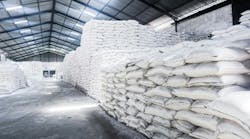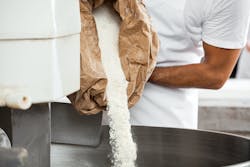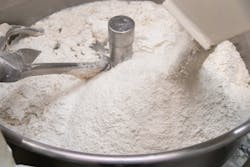In manufacturing of all types, powders and bulk solids can be either the final product, one of various ingredients or the raw material needed for production — and that includes food and beverage processing operations.
Companies that manufacture the products we eat and drink handle all types of base ingredients, raw materials during processing — and some of the final products themselves are powders or bulk solids.
Most powder-handling concerns that plants need to work through are not limited to food and beverage-related operations. High priorities for manufacturers of all stripes are ensuring proper flow of the materials through the system to support product quality and efficient delivery of the material and maintaining safety of the operation by preventing leaks in the system and mitigating the creation of dust.
Product flow can be a significant challenge dependent upon the characteristics of the powder being transported. In fact, Tom Blackwood, a veteran engineer who has dealt extensively with solids over the course of his career and is the “Solid Advice” columnist for our sister magazine Chemical Processing, stated in his most recent column that, “Poor flow is a given with most solids, and predicting the flow characteristics is a difficult and expensive proposition.”
As mentioned previously in this publication, powders and bulk solids do flow, but they behave differently than liquids, and different tactics need to be adopted to ensure they flow properly and safely. Matt Beier, senior process engineer for engineering and construction firm CRB, says system design means everything when it comes to product flow, blending and packaging of these types of products.
“Each product stored may require a different type of hopper bottom on the storage silo/bin to ensure flowability — it could mean live bottoms, 60- to 70-degree cone, wedge, chisel, eccentric bottoms, etc., to ensure that flow,” he explains. “Each powder has a personality, and that must be determined and the knowledge utilized in the design to make the powder transfers successful.”
Added challenges for food and bev
There are two additional challenges the food & beverage industry faces that stray from those faced by other industries when it comes to powder and bulk solids handling, says Beier. First of all, the diversity and amount of powdered materials used in processing make handling of these items in a food plant a completely different animal.
“[The food industry] extensively employs a diverse array of powder ingredients sourced from all corners of the world,” he says. “A food plant may need to handle literally hundreds of powder ingredients, each with its unique storage and transport requirements that must be integrated into the overall design.”
When combining powders and bulk solids, processors need to engage their technicians from the start to determine how safely and efficiently to blend those powders on the production line and then move them on to the next step for further processing or packaging (if the blend is the final product).
“It is customary to conduct multiple mixing studies to determine how ingredients interact with each other, considering factors such as degradation, the optimal order of addition during mixing and the required mixing time,” Beier adds. “Furthermore, after mixing, a combination of powders that may not have been explosive individually could potentially become explosive — hence, testing is essential to ensure such a mixture, if created, adheres to the necessary safety controls.”
To that end, although safe handling needs to be considered when any powdered materials are being blended, moved or stored, the food & beverage industry also must consider and protect the food safety of the powders and solids. The ultimate quality of the product relies on similar mixing and blending studies, as well as proper design of the handling system to avoid clumping of ingredients or powders getting stuck along the line.
“Since these ingredients are intended for human or pet consumption, they must be handled and stored in compliance with the most stringent food safety standards,” Beier adds. “The ongoing challenge with every powder-based system lies in devising effective cleaning methods to ensure food safety and prevent allergen contamination; each type of conveyance comes with its own unique set of challenges.”
Processors need to examine closely the material properties of the powders and solids they need to transport before determining the types of equipment they need — and thus, the best methods by which to clean those lines. Screw conveyors, bucket elevators/belts, pneumatic (pressure or vacuum) conveyance systems all have their pros and cons.
For screw conveyors, Beier says, it can be particularly difficult to get completely clean without flushing with an inert product or utilizing clean-in-place (CIP) washing methods. Bucket elevators/belts can be washed down and cleaned but aren’t practical for effective powder/dust control.
When it comes to pneumatic conveyance systems, Todd Smith, business and strategy manager at the Bulk Solids Innovation Center at Kansas State University, chimes in on the differences in the October 2023 issue of Bulk Solids Innovation Center Journal. In his article, “Is Pressure or Vacuum Conveying Better for Your Pneumatic Conveying System?” Smith says vacuum conveying systems are typically cleaner to operate, a critical benefit in the food and pharmaceutical industry.
“Because it is under vacuum, small leaks aren’t an issue since dust does not leak out,” Smith writes. “The advantage is significant at the pickup point where material enters the system, especially if material comes from any type of open container. Getting material out of bags, boxes and drums is easy with a vacuum system and much less messy than with a pressure system.”
That said, although pressure conveyance systems can make a bigger mess, they operate more efficiently than their vacuum-driven brethren. Beier adds that pneumatic conveyance overall can achieve an unmatched level of cleanliness using inert material flushes, dry ice, walnut shells or salt. Yet, for food processing applications, that can present its own set of challenges due to allergen contamination. Many processors, he adds, opt for a salt flush due to its inert nature, harmlessness to most diets, ready availability and cost-effectiveness.
Liquid clean-in-place has been attempted for sanitation of pneumatic systems, but there have been challenges around getting the system dried completely and properly. “In the realm of food safety, introducing a liquid to a dry system is considered highly problematic, as even a small amount of water can promote the growth of microorganisms.”




